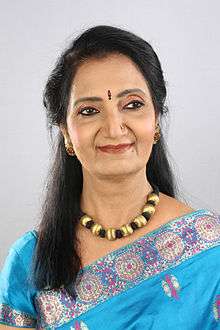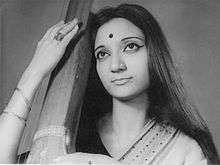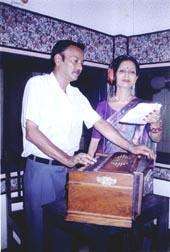Beauty Sharma Barua
| Beauty Sharma Barua | |
|---|---|
 Beauty Sharma Barua in 2011 | |
| Background information | |
| Birth name | Beauty Barua |
| Also known as | Beauty Baideu |
| Born |
June 18, 1951 Dafalating Tea Estate, Golaghat, Assam, Eastern India, |
| Origin | Assamese |
| Genres | Assamese music Folk Music Indian Classical Music Ghazal Bhajan |
| Occupation(s) | Singer |
| Years active | 1958–present |
Beauty Sharma Barua (Assamese: বিউটি শর্মা বৰুৱা, born on June 18, 1951) is a singer from Assam, India. She is one of the best-known and most respected Assamese folk music, Indian classical music, ghazal and bhajan singers of Assam. More popularly known as The Melody Queen of Assam and Beauty Baideu, she has recorded over a thousand songs for All India Radio, Doordarshan, albums and others. She has sung songs in over six regional Indian languages, though primarily in Assamese and Hindi. She is the great grand daughter of Lakshminath Bezbaroa and Pragnasundari Debi, who belonged to the family of Rabindra Nath Tagore. Beauty Barua married renowned writer and lyricist Dwijendra Mohan Sharma (1948–2006), called the Man with Melody in His Pen by The Daily Telegraph, in 1976.[1][2]
Early life
Beauty Sharma Barua was born in Dafalating Tea Estate, Golaghat, Upper Assam. Her father was Bhubaneshwar Barua, a Tea Estate manager and her mother was Nirmala Devi.
Beauty Sharma Barua took her first lessons in light folk music at the age of 3 from different gurus from Jorhat. Since the age of 5, she started teaching folk songs to children of tea estate workers at the Dafalating Tea Estate and emerged as a child folk singer at the age of 6. In 1958, when she was 7, she was facilitated by the first Prime Minister of independent India, Pt. Jawaharlal Nehru for her singing capabilities. Since the age of 9, she was trained in Indian Classical Music by maestros like Rajmohan Das, Tulsi Chakraborty, Anil Dutta, Lakshi Saikia and Pandit Motilal Sharma from the Kirana Gharana, later Indore Gharana. She was also trained in other light classical forms of music like Dadra, Thumri and Kajri by Begum Akhtar and Ghazal by Bal Gautam.
Singing career
Early career in the 1960s
Since the 1960s, Beauty Sharma Barua started gaining popularity through her songs aired by All India Radio Guwahati, Shillong, Jorhat and Dibrugarh including special shows on her hosted by All India Radio, Imphal. She was more known for her Ghazal, Bhajan and Indian Classical Music than Assamese Folk Music then. Her first song recorded by All India Radio, Guwahati was Tumaloi Monot Pore, written by Nurul Haque and Music by Jitu Tapan in 1968. This song was recorded as a duet with Bhupen Hazarika in 1972. Her second ever recorded by All India Radio was O Rojonigondha in 1968. This song was written Lila Gogoi and composed by Lakhi Saikia. She gained early popularity for being one of the few singers singing raga based songs in Assam then recording over 50 songs including Xouwa Neel Neel (1969) and Mon Dilu Tomak (1969).
1970s

Since the 1970s, Beauty Sharma Barua sang songs for various Music Directors of the time including Bhupen Hazarika, Jayanta Hazarika, Khagen Mahanta, Indreshwar Sarma, Subir Mukherjee, Lakshi Saikia, Jitu Tapan, Mukul Barua, Jiten Deb, Hemen Hazarika, Amiadhar Barua, Anil Barua, Birendra Nath Phukan, Dilip Sarma, Mohammad Hussain, Jagadish Barua, Deben Sarma, Prabhat Sarma, J.P Das, Bipul Barua, Utpal Sarma, Atul Dev Sarma, Ramen Choudhury, Anupam Choudhury, Hiren Gohain and Jyotish Bhattacharya. Her voice was rendered to some of the legendary song writers of Assam, including, Jyoti Prasad Agarwala, Bishnu Prasad Rabha, Laxminath Bezbarua, Parvati Prasad Baruwa, Mitradev Mahanta, Bhupen Hazarika, Nabakanta Barua, Darpanath Sarma, Lila Gogoi, Lakhyahira Das, Keshav Mahanta, Tafajul Ali, Usuf Hazarika, Nurul Haque, Sandhya Devi, Idris Ali, Hiren Bhattacharyya, Amit Sarkar, Anuradha Das, Hemanta Goshwami, Kirti Kamal Bhuyan, Nagen Bora and Mukul Barua. Her gramophone record album with Bhupen Hazarika released by HMV Records in 1972 was a best seller. Duets like Tumaloi Monot Pore and Tumi Joon Ne Xoon with Bhupen Hazarika introduced a new trend of modern folk music in Assam.
Some of her famous songs during the 1970s included Proja Poti Jhilmil Pakhi (1970), Etiya Polom Hol (1970), Chandrawoli Nixa (1971), Un Mona Hoi Mone (1971), Tumi Joon Ne Xoon (1972), Tumaloi Monot Pore (1972), Tumi Xudha (1973), Xorot Ahile Henu (1973), Prothom Torati (1974), Maya Mrigo (1974), Akash Neela (1975), Tumar Kotha Jetiya Bhabu (Later sung by Jayanta Hazarika)(1975), Monore Xima Rekha (1975), He Maya Bini (1975), Gharmua Pokhi (1976), Ei Xapoon Mur (1976), Mah Halodhi (1977), Kokalot Gagori (1977), Xipare Jamuar (1978), Devi Buli Matisilu (1978), Moi Nodit (1979) and Moi Sondo Hara (1979). After her marriage to Poet and Lyricist, Dwijendra Mohan Sharma in 1976, Assam saw another new trend in melody blended between Assamese Folk Music and light Classical. The birth of evergreen compositions like Mah Halodhi, Ghar Mua Pokhi, Xipare Jamunar, Devi Buli Matisilu, Dighal Koi Uroni, Habiye Habiye, Ujoni Mua Rail Gari, Tup Tup Robha Toli and Kokalot Gagori written by Dwijendra Mohan Sharma and sung by Beauty Sharma Barua, are still amongst the most melodious songs loved by people of Assam. Beauty Sharma Barua has sung over 300 songs written by Dwijendra Mohan Sharma since the 1970s till now.
1980s

The 1980s saw the rise of one of the most respected music schools of Assam, the Alakananda Sangeet Vidyalaya, started by Beauty Sharma Barua. This music school has seen multiple singers emerge into the global scenario through the training imparted by Beauty Sharma Barua. Her disciples were known to be some of the most classically trained singers in the state, especially in genres like Ghazal, Bhajan and Assamese Folk Music. Her students started demonstrating expertise in practically any form of music through the strong base created by the legendary singer. In 1988, the children learning music at the Alakananda Sangeet Vidyalaya won multiple awards for their songs sung in the album, Umola Ghoror Geet, which was directed by Beauty Sharma Barua and composed by Dwijendra Mohan Sharma. The song Seuji Sopot from the album is still used as a theme for the Green Revolution in Assam.
During the 1980s, she sang some of the best light classical based melodious songs of her time which are still amongst her greatest hits today. Her most famous Indian classical based songs include Bonei Bone (1980), Shyam O Shyam (1980), Megh Nathakile (1980), Kiyo Jaanu Mur (1981), Xao Nao Borosaat (1982), Nibe Nimati Rati (1984), Kaar Xure Xure (1986) and Buku Apun Aai (1987) . Some of her most melodious songs of the period are Joon Tora Raati (1981), Dighol Koi Uroni (1981), Tup Tup Robha Toli (1981), Aha Naa Kua Naa (1981), Rati Xaare Ase (1982), Sandhiya Hole(1982), Dori Kona Maas (1983), Besi Din Logot Nathaku (1984), Akajoli Xur (1985), Mon Kiyo Aji (1985), Xorot Xitol (1986), Duronire Pora (1986), Kaali Ratir Xapun (1987), Agoli Kolore Paate (1987), Najau Aji Ghoroloi (1988), Habiye Habiye (1989).
1990s onwards
From the 1990s onwards, Beauty Sharma Barua worked with multiple music directors and brought in some of the most popular songs in Assam including Eman Apun Hoiyu (1991), Bota Sorai (1991), Maya Bhora Raati (1991), Dubori Buku (1991), Kun Ropohi Tai (1992), Suruj Mukhiye Kole (1992), Lorajon Xodiye (1993), Ulai Saalu Dekha Paalu (1993), Kauri Kaa Kaa (1994), Misingor Sangote (1994), Nas Bandor Nas (1995), Ja Ja Jiya (1995), Xi Jhune Buto (1996), Ujoni Mua (1996), Bhor Duporia (1997), Deu Di Nasili (1997), Ratite Phuli Utha (1997), Eijora Band Party (1998), Lorajon Sadiye (1998), Dhuliya Bihu Wa Dhulotu (1999), Gaor Manuhe Koi Bhute Dhorise (1999), Ei Je Abile Bela (1999), Xunali Xunaru Phoolise (2000), Kun Rupohir Gohona Jeelikay (2001), Dug Dug Madolore Maat (2001), Xun Ne Rup Ne (2001), Pooja Pooja Botorote (2002), Jetuka Patere (2002), Jobonor Noi (2003), Sandhya Nami Bokul Bonot (2003), Botahote Haale Jaale (2003), Ajiye Godhuli Bela (2003), Akasot Junakor (2004), Eti Proshno Mur (2004), Klanto Ratir Tora (2004), Rupore Agoni (2004), Xopunor Maya Bhora (2004) and others.
In 1999, her album Nao Koina brought in a new dimension to marriage songs and was the common background music in Assamese Weddings. Apart her songs in albums like Xorotor Xondiya, Parinita, Upasana, Joan, Atitak Xuori and Shri Shri Durga topped the charts in the state.[3][4] After the success of Noa Koina, another marriage album listing her most popular songs, Daponmoti, was released in 2005. After the death of Dwijendra Mohan Sharma in 2006, which came in as a huge shock to the people of Assam, she was inspired by all eminent musicians in Assam to continue her singing and keep the legend, Dwijendra Mohan Sharma alive. In 2007, she published a book on children’s songs, Umola Ghoror Geet, which contained 56 songs written by Dwijendra Mohan Sharma along with staff notations for the tune. These songs were sung by children and a popular Assamese children’s album with the same name was released in 2007. The death of Dwijendra Mohan Sharma inspired her to write her first composition as a dedication to the legend released in an album, My Ornate Life With The Legend, in 2008. One of her most popular albums, Moonlight Melodies, was also released in the same year. The Music Director for both the albums was Bhupen Uzir. The late 2000s find her travelling across India taking Assamese music across different states. She has sung multiple songs in different Indian languages including Hindi, Marathi, Punjabi and Kannada apart from translating Assamese songs into those languages. In 2012, her album, Mah Halodhi, has been one of her bestsellers with millions of fans enjoying her most popular numbers.[5][6]
Non-singing career
Apart from her singing, she directed multiple musical shows on Doordarshan and All India Radio on various themes and various eminent singers from Assam took part in those television shows. She also had a few acting stints in Protichobi, Dapon and Pratighat, and rendering her voice in Atma Mariyada, a popular Assamese soap.
References
- ↑ "Dwijendra Mohan Sharma". The Daily Telegraph. July 26, 2007. Retrieved 2011-12-03.
- ↑ Enajori (September 21, 2004). "Musical Minds". Enajori. Retrieved 2011-08-19.
- ↑ "An Evening of Enchanment". The Telegraph. July 20, 2007. Retrieved 2011-12-03.
- ↑ "New Doordarshan Serial Maa". The Sentinel. July 24, 2007. Retrieved 2011-12-03.
- ↑ "Beauty Sharma Barua". The Sentinel. January 28, 2012. Retrieved 2012-01-28.
- ↑ "Beauty Sharma Barua". Deccan Herald. July 14, 2013. Retrieved 2015-03-09.
See also
| Wikimedia Commons has media related to Beauty Sharma Barua. |